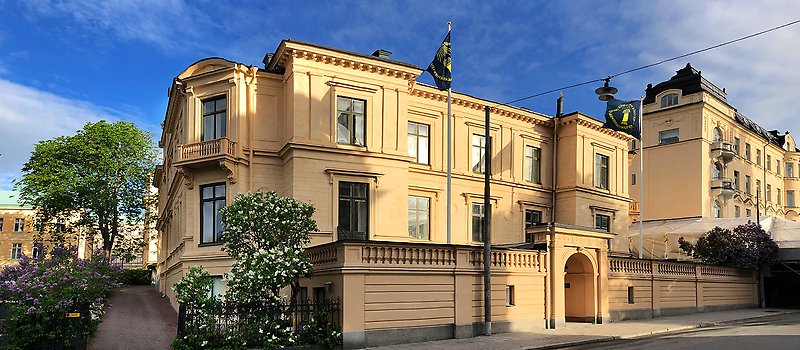
The Royal Swedish Academy of Letters, History and Antiquities
About the Academy
Queen Lovisa Ulrika founded Kongl. Swenska Witterhets Academien, the Royal Swedish Academy of Letters on 20 March 1753. Today, as the Royal Swedish Academy of Letters, History and Antiquities, the Academy advances and funds research in the humanities and social sciences and in cultural heritage management. Its work is financed by donations and by public and private foundations.
The Academy also owns and manages five heritage properties: Skånelaholm Castle in Uppland, Stjernsund Castle in Närke, Rettig House in Stockholm (which houses the offices of the Academy), Stensjö in Småland and Borg with the ringfort of Gråborg on Öland.
The Academy promotes and supports research by funding research projects, research positions, publications, symposia, conferences, projects in internationalisation and digitisation, travel grants, and scholarships. It has several research collaborations with universities and research funding bodies, including the Swedish Research Council, Riksbankens Jubileumsfond, and Sweden’s other royal academies. It also collaborates with international learned societies and national academies. It provides expertise when requested by government committees or official commissions of inquiry or when its own interests so require. At its Annual Meeting, held annually on 20 March to mark its foundation, the Academy acknowledges leading researchers through prizes, awards, and medals. The Academy publishes its own journals and book series and supports important scholarly journals.
Mission and priorities
The Academy’s mission and priorities are:
- to advance research and other activities in the humanities, religion, law, and the social sciences and cultural heritage management;
- to collaborate with Swedish public bodies and associations with similar scholarly aims and objectives;
- to initiate and support international collaborations in Vitterhetsakademien’s fields of interest and thus to maintain ties with national academies and international learned societies;
- to publish a variety of scholarly publications in Vitterhetsakademien’s fields of interest;
- to confer grants and awards upon leading researchers and others who have advanced Vitterhetsakademien’s aims and objectives;
- to offer its expertise in the Academy´s fields of interest at the request of government or public bodies, or when the Academy’s interests so require. (From the Statutes of the Royal Swedish Academy of Letters, History and Antiquities)
For much of its history, Vitterhetsakademien was closely linked to the Swedish National Heritage Board in its organisation and work with, for example, museum collections, the protection of historical monuments, and publishing. From 1786, the head of the Swedish National Heritage Board was also the secretary of Vitterhetsakademien. A donation in the early 1880s gave the Academy greater freedom to take its own initiatives, and in 1975 the Academy and the Swedish National Heritage Board divided into separate organisations, since when Vitterhetsakademien has been an independent learned society, supporting research in the humanities and social sciences and in cultural heritage management. Over the years, it has built up a substantial capital from numerous donations, some in specialist foundations and funds for the advancement of learning, research, and cultural heritage management.
The Academy supports a large number of conferences and symposia, and it works to promote excellence by backing high-potential academic projects, especially those not prioritised by public research funding bodies. There are annual open calls for applications from its foundations and funds, while the Academy or its members often launch major initiatives. The result has been several very long-term projects, which for various reasons could not be publicly financed.
The Statutes of the Royal Swedish Academy of Letters, History and Antiquities
The Academy’s mission is set out in its statutes Pdf, 156.2 kB. (last revised 27 June 2019).
Pdf, 156.2 kB. (last revised 27 June 2019).
The name of the Academy
When the Academy was founded by Queen Lovisa Ulrika on March 20, 1753, it was named Kongl. Swenska Witterhets Academien (the Royal Swedish Academy of Letters). When Gustav III reconstituted the Academy in 1786, it was given the name that is still current: Kungl. Vitterhets Historie och Antikvitets Akademien. In everyday usage, it is most commonly referred to as Kungl. Vitterhetsakademien.
The name of the Academy in English, French and German:
The Royal Swedish Academy of Letters, History and Antiquities
Académie Royale Suédoise des Belles-Lettres, de l'Histoire et des Antiquités
Königl. Schwedische Akademie für Literatur, Geschichte und Altertümer
The Royal Swedish Academy of Letters, History and Antiquities
Phone: +46 8-440 42 80
Bank: 535-3552
E-mail:
kansli@vitterhetsakademien.se
Postal address:
Kungl. Vitterhetsakademien
Box 5622
114 86 Stockholm
Visiting address:
Villagatan 3, Stockholm
© THE ROYAL SWEDISH ACADEMY OF LETTERS, HISTORY AND ANTIQUITIES

